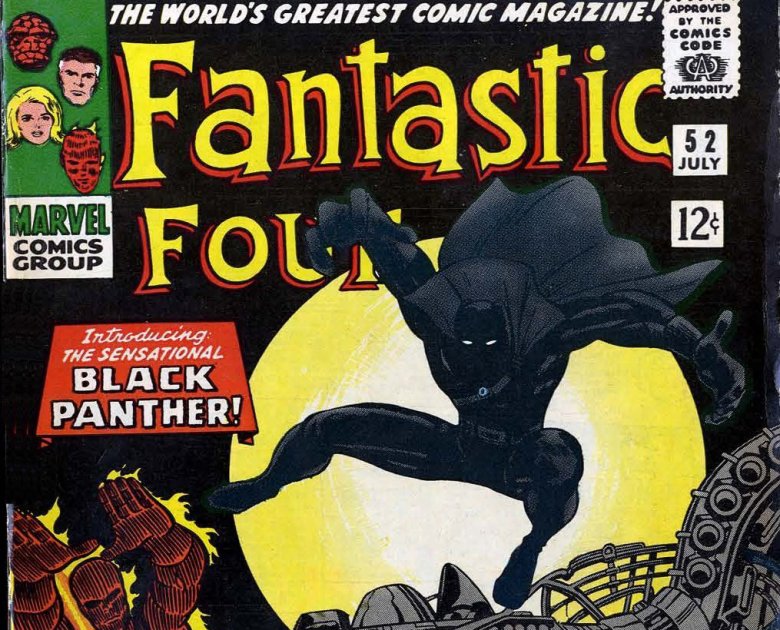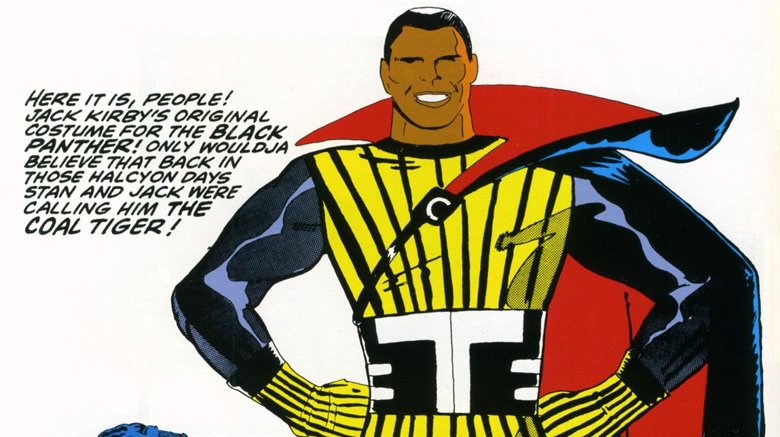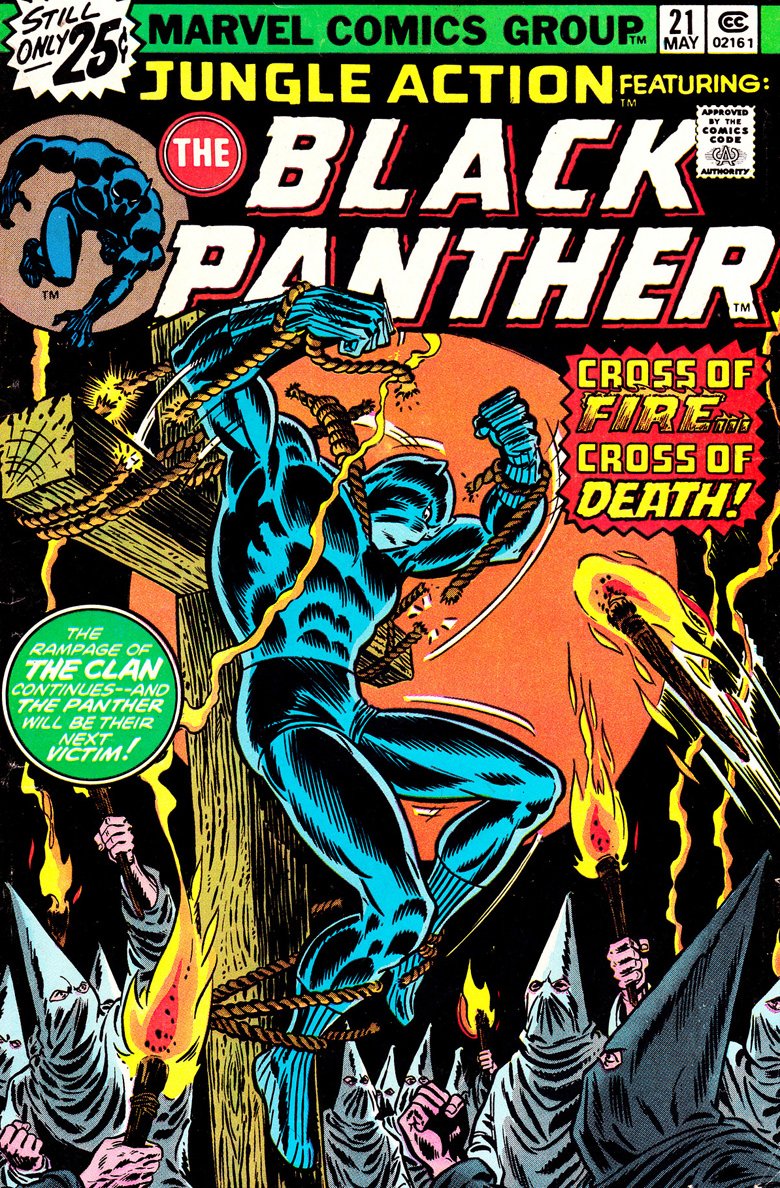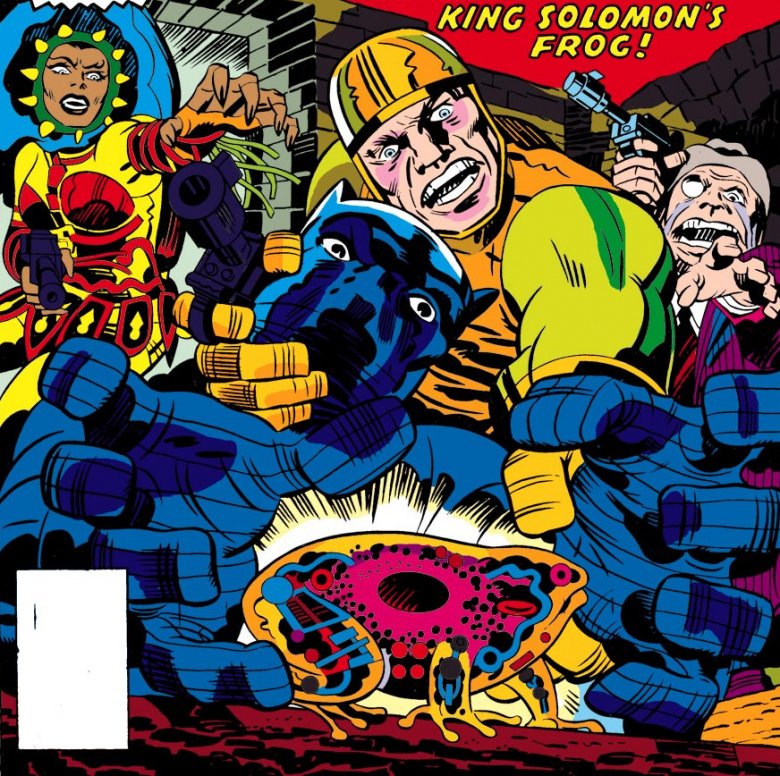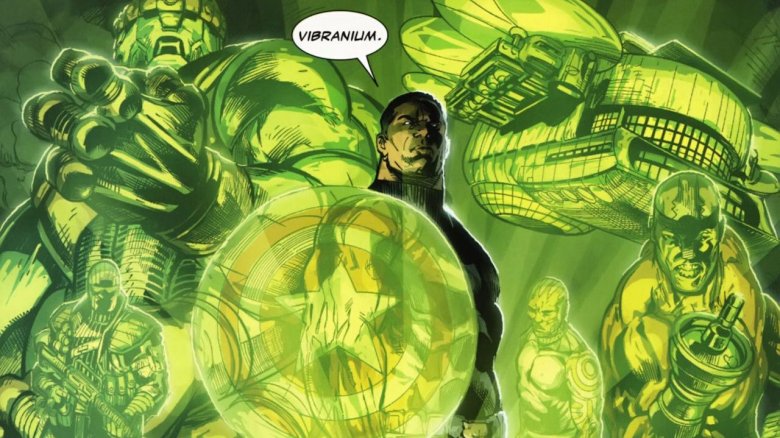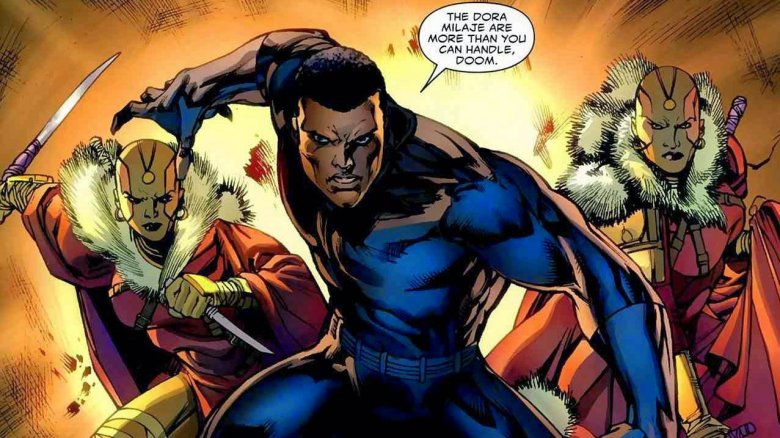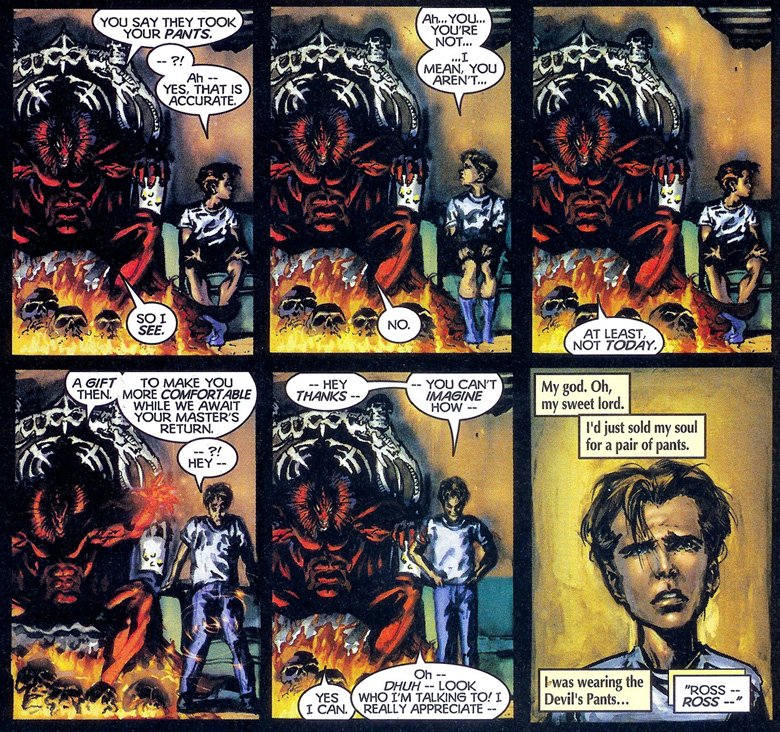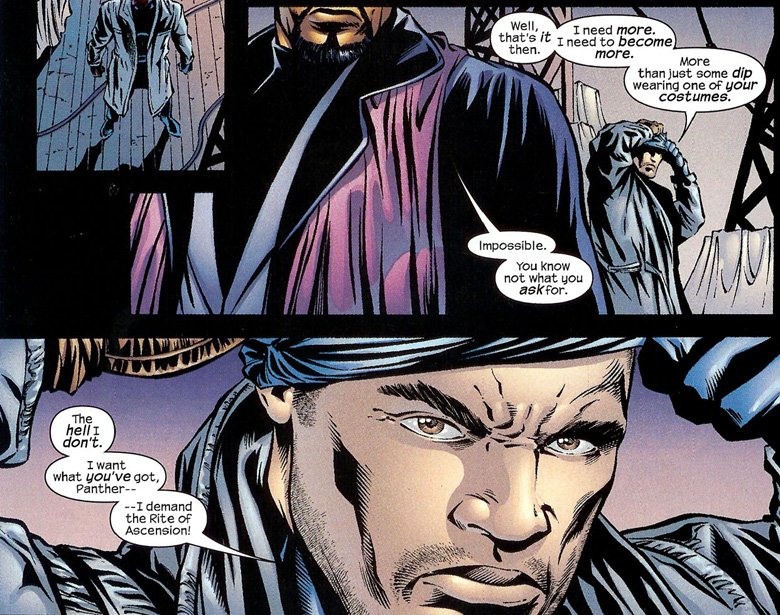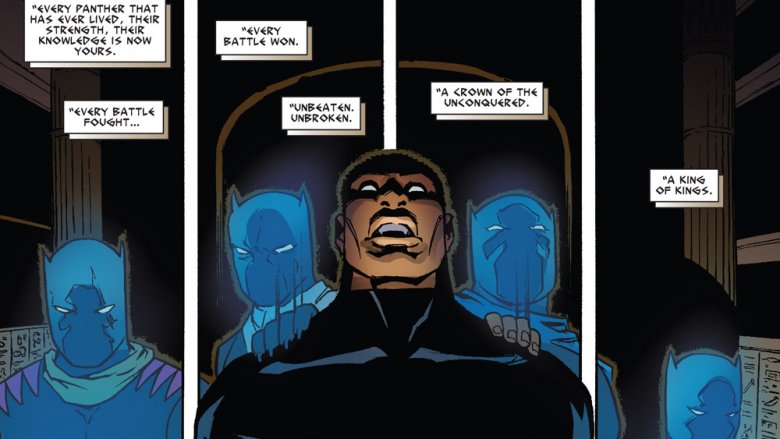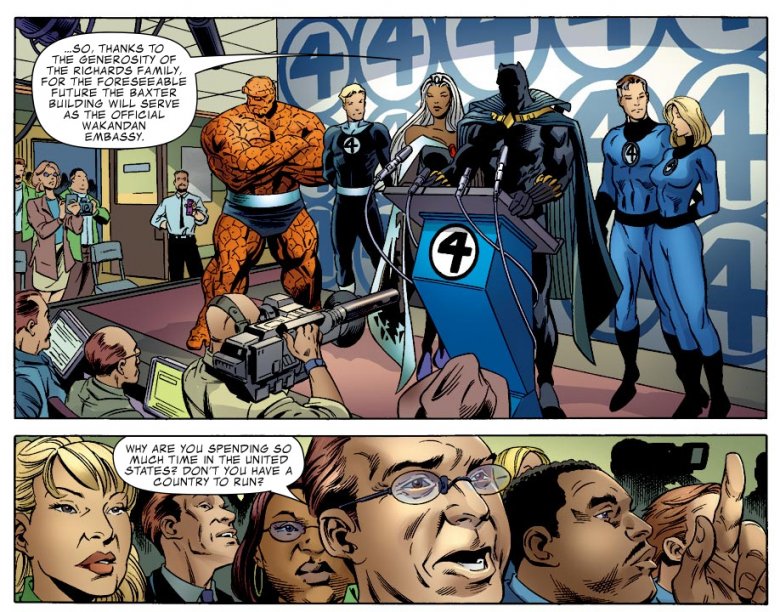Things You Didn't Know About Black Panther
He's the breakout star of the Marvel Cinematic Universe, but Black Panther is hardly new to superheroics. Since making his debut over 50 years ago, he's been a part of countless comics adventures, from gritty fights with crooks and Klansmen to cosmic journeys to the depths of space. With that much action, there are bound to be a few odd bits that you've missed.
With that in mind — and with the Black Panther movie taking its place in the MCU pantheon — we're looking back over the less-traveled corners of the character's rich history. From magic frogs that control space and time to the untold story of the T'Challa's first ill-fated journey to the big screen, here's what you don't know about Black Panther.
The first black superhero
Black creators were a part of comics from the very beginning. In fact, Golden Age artist Matt Baker, probably best known for his work on Phantom Lady, was one of the earliest pioneers of the longform adult-oriented graphic novel with his work alongside writer Arnold Drake on 1950's pulpy crime story It Rhymes With Lust. On the page, however, things were drastically different. There were a few attempts at making comics directed at an African-American audience, but with the early days of mainstream superhero comics, most black characters were sidekicks rooted in unfortunate racial stereotypes.
In 1966, however, Stan Lee and Jack Kirby took steps to correct that by introducing a new character in their flagship title. Fantastic Four #52 introduced the world to T'Challa — better known as Black Panther — king of the African nation of Wakanda. When he was asked about it by Gary Groth in the pages of The Comics Journal, Kirby pointed to a very simple reason for creating the character: he realized that there weren't any black people in his comics, and thought that was a problem to be corrected.
"I came up with the Black Panther because I realized I had no blacks in my strip. I'd never drawn a black. I needed a black," Kirby recalled. "I suddenly discovered that I had a lot of black readers. My first friend was a black! And here I was ignoring them because I was associating with everybody else."
With that, the Panther was introduced in a story where he invited the FF to his secretive, ultra high-tech homeland, only to take them all out in a massive battle in order to test them and find them worthy of helping them. Not a bad debut.
Introducing ... The Coal Tiger?
The version of T'Challa that hit the page in his first appearance sported the sleek, all-black costume that he's worn, with a few modifications, ever since. Kirby's original designs, however, not only sported a different costume, but a different name: the Coal Tiger.
As for how he wound up as the Black Panther, a lot of people erroneously attribute it to a connection with the activist organization of the same name, but that's not the case. The Black Panther Party was officially founded in California in October of 1966, a few months after the character made his July debut in the comics. And while Lee and Kirby, both New Yorkers at the time, were prone to telling slightly more politically savvy stories than their peers, it's doubtful they would've been quite that quick to jump on a hot-button issue. Either way, the association led Marvel to briefly change the character's name to "the Black Leopard," complete with an in-continuity bit of dialogue from T'Challa in FF #119 about how he "neither condemned nor condoned" the actions of the Party, but wanted to maintain his individuality.
The "Coal Tiger" name wasn't completely forgotten, though. In the "MC2" continuity — a version of the Marvel Universe set a generation after the current stories and mostly focused on Peter Parker's daughter, Spider-Girl — T'Challa's son T'Chaka used it as his own superheroic codename.
The Panther fights the Klan
While the Panther would remain a fixture in Fantastic Four for the rest of the '60s after his first appearance, and would join the Avengers in 1968, the early '70s saw him launched into his first solo adventures. It happened in the pages of Jungle Action #6, and over the next 18 issues, Don McGregor, Rich Buckler, Gil Kane, and Billy Graham would tell one of Marvel's most lauded stories.
The series introduced foes like Erik Killmonger and Venomm (a snake-themed villain not to be confused with the Spider-Man baddie of the same name), but reached its heights in #19, when McGregor and Graham pit the Panther against the Ku Klux Klan. Set in Georgia, the story focused on Monica Lynne, a singer who became the Panther's longtime love interest, and as you might expect, dealt heavily with racism and the intimidation of black families in America. It's full of striking imagery, and one issue even ends with the Panther strapped to a burning cross — before he frees himself, batters his way through the crowd with the wood still tied to his back, and returns to stomp a mudhole in the entire group.
It's an incredibly pivotal story for Marvel. All Star Superman writer Grant Morrison cited McGregor's "lyrical allusiveness" in #19 as a huge influence on his work, and the legendary Dwayne McDuffie called it "the most tightly-written multi-part superhero epic ever" that was "everything a super-hero comic should be."
King Solomon's Frogs
As befitting the first black superhero, Black Panther is an incredibly powerful character. The heart-shaped herb T'Challa ate as part of the ritual to take his title has granted him enhanced strength, speed, and reflexes; he has a genius-level intellect that puts him on par with big brains like Tony Stark and Reed Richards; and he has control over not just an entire country, but the majority of the world's supply of Vibrainum, a super-metal that enhances his costume and provides Wakanda with its extremely advanced technology. Oh, and he also has a pair of brass frogs that can control space and time.
When Jack Kirby launched the Black Panther solo title in 1977, he wasted no time in sending him on a mystical sci-fi adventure that saw T'Challa recovering King Solomon's Frogs. The first was owned by T'Challa's grandfather when he was king of Wakanda, and upon examination, wound up being a time machine. The second allowed for travel through space, but both were unpredictable enough that he only uses them sparingly — the first time he tried them out, the Time Frog wound up pulling a hyper-evolved weirdo named Hatch-22 into the '70s from 6,000,000 years in the future.
Eventually, it would turn out that there were three frogs, and that when you brought them together, they formed what was called a Concordance Engine, a machine that can destroy, rebuild, or otherwise alter the entire universe. So, you know, a good thing to have down in the basement just in case you need it.
Good Vibranium
Comic books are full of special metals, from Wolverine's famous adamantium claws to DC's significantly less famous Batmanium — no, really, that one's actually in comics — but none are quite as interesting as Vibranium. It's got plenty of superheroic properties, and is only found in two places on Marvel's version of Earth: Wakanda, and the dinosaur-filled Antarctic jungle known as the Savage Land.
Wakanda's variety is known as "True Vibranium," and its rarity is attributed to the fact that it's not actually native to Earth. Instead, the mountain from which it's mined is actually a massive meteorite. As the name suggests, it has the ability to store and discharge vibrations, including the kind that come with a kinetic impact. In short, it's able to withstand and even reflect energy, which makes it pretty useful as part of the alloy that makes up Captain America's shield.
It's also used in plenty of other Marvel Universe artifacts: Hawkeye's arrows, Warpath's daggers, and the Constrictor's coils all employ Vibranium. Most prominently, though, you can find it in the Panther's strength-enhancing, bulletproof costume.
The Dora Milaje
When Christopher Priest and J.G. Jones relaunched Black Panther in 1998 as part of the Marvel Knights imprint, they delved into Wakanda and its culture in a way that hadn't really been done before. One of the most important additions was the idea of the Dora Milaje.
Translated as "Adored Ones," the Dora Milaje are highly trained, highly effective warrior women who serve as the Black Panther's bodyguards — and the fact that they're protecting a bulletproof, super-strong member of the Avengers should give you a good idea of just how tough they are. They have a second function, though, hinted at by their names: they're also potential wives.
According to Priest and Jones, the selection of the Dora Milaje is designed to keep peace among the different factions of Wakandan society that are all vying for influence in T'Challa's royal court. Each member of the Dora Milaje comes from each faction, and as long as the Panther doesn't favor one over any of the others, peace is maintained. Which might be why, when he actually did get married, it was to Storm of the X-Men rather than one of them.
Everett Ross, the sidekick who sold his soul for pants
If you've been paying attention to the Marvel Cinematic Universe, then you may already be familiar with Everett K. Ross, the CIA agent assigned to deal with some of the more official aspects of life in a universe full of superheroes. In the movies, he's played by Martin Freeman, and made his first appearance in Captain America: Civil War, interrogating Baron Zemo for his crimes.
In the comics, however, he had a bit of a rocky start. As an agent working for the State Department's Office of the Chief of Protocol, he was assigned to be a liason to Black Panther during the Wakandan hero's visit to America. Needless to say, the self-proclaimed "king of the useless white boys" was woefully unprepared to be pulled into the world of superheroics, and wound up being dragged along as a viewpoint character on what could charitably be called "misadventures."
Perhaps his scariest moment came early in the series. After losing his pants in a mud-wrestling match (long story), Ross found himself visited by Mephisto, the closest thing that the Marvel Universe has to the actual devil. Sitting next to each other in an apartment, with Ross on the couch and Mephisto on a flaming throne of skulls that he conjured up from the depths of Hell, the two characters shared a moment when Mephisto granted Ross a new pair of jeans, leaving Ross wondering if he had accidentally sold his soul for pants. Which, to be fair, isn't the worst possible reason to damn your immortal spirit.
Kasper Cole, the second Black Panther
While he's definitely the character most identified with the identity of the Black Panther, T'Challa isn't the only person to ever step into that role. His father, T'Chaka, was the Black Panther before him, of course, and at one point, the villainous Erik Killmonger even claimed the title for himself.
There was, however, a second heroic Black Panther: Kasper Cole. Introduced in 2002 by Christopher Priest and Dan Fraga, Cole was created, as Priest wrote, as "a dark satire of Spider-Man, structured around the nuclear family concept of The Hero Who Could Be You." He was a cop in Harlem looking to be promoted to homicide detective who stole a costume from an evidence locker and adopted the identity of the Black Panther in order to clean up his neighborhood during the time when T'Challa had given up his role. Obviously, this brought him into conflict with both the bad guys and with his predecessor, and while he demanded the Panther's Rite of Ascension, he wound up having his abilities enhanced thanks to a synthetic version of the mystical Heart-Shaped Herb — provided to him by Killmonger in exchange for a future favor.
While T'Challa eventually reclaimed his identity, Cole instead began using the codename White Tiger — part of another heroic legacy shared by multiple characters in the Marvel Universe. After his Black Panther series ended, he helped form a team called the Crew that included Jim Rhodes, better known as War Machine, and continued his work fighting inner-city super-crime. Whether he ever got that promotion remains unknown.
King of the Dead
One of the more recent developments in Black Panther's life came in 2012. Once again, T'Challa had given up the title of the Black Panther, with his sister Shuri taking over in his stead as both Black Panther and Queen of Wakanda. Unfortunately, she inherited a pretty big problem, in that the hyper-advanced nation was now being attacked constantly by hordes of the undead. Mondays, right?
In order to solve the problem, T'Challa descended into the underworld — figuratively and literally — to confront an ancient goddess. After receiving glimpses of future tragedies set to befall Wakanda, and admitting that he still desired the position of the Black Panther despite not wanting any harm to befall his sister or his rule, T'Challa was given a new role: King of the Dead. Blessed by Bastet, he was restored to his old strength, and given all the memories and knowledge of every Black Panther before him.
Leader of the Fantastic Four
When Dwayne McDuffie and Paul Pelletier took over Fantastic Four in the aftermath of Civil War, they were given a team with a pretty big problem. Reed Richards had just been on the winning but pretty immoral side of the Superhero Registration Act conflict, which had led him to help build a cybernetic clone of Thor that went rogue and blew a hole in a lesser-known superhero called Goliath. Naturally, this put a little stress on his marriage.
McDuffie and Pelletier's solution was to send Reed and Sue Storm off on an outer-space spa vacation to work on their marriage, but that left only two members of the team back on Earth, and "Fantastic Two" doesn't really have the same ring to it. That's why, for a short time, the FF got two new members in the form of one of Marvel's other most prominent married couples: the Black Panther and Storm.
Stepping into their new roles (and giving the Human Torch and the Thing some color-coordinated black FF costumes), T'Challa and Ororo led the team on a cosmic adventure to the depths of space. They took on Galactus and the Silver Surfer, and Panther proved that not only was he capable of out-wrestling the Surfer, but that he was prepared with a machine that could allow him to absorb and channel the Power Cosmic — and he even used King Solomon's Frogs to do it.
The Black Panther movie that wasn't
Superhero fans are undoubtedly familiar with Wesley Snipes from his role as Blade in the movie series of the same name. Hitting screens in 1998, the movie not only gave Marvel its first cinematic hit and launched a franchise that blended vampiric horror and hard-hitting action in equal measure, it also showed that second- and third-tier superheroes could be given a new life in film with the right idea behind them. But what even diehard fans might not know is that Blade wasn't Snipes' first attempt to bring a superhero to life. Long before Ryan Coogler took the helm with Chadwick Boseman, Snipes was dead set on playing the lead in a Black Panther movie.
As revealed by The Hollywood Reporter, Snipes was involved in the mid-'90s in a potential film that, as he put it, would use the "fantastic, glorious periods of African empires and African royalty" as the basis to bring an inspirational new superhero to mass market audiences across the world. He wanted Wakanda, Vibranium, the force field, and the kind of comics-accurate costume that would require him to be, and we quote, "in shape and just be straight bodied up."
Unfortunately, as we all know, there's always someone ice skating uphill. While Snipes met with director John Singleton and screenwriter Terry Hayes — whose origin story for the Panther included a thematic callback to the story of Moses — the project never came together. Instead, Snipes went on to take a very successful risk as the Daywalker, and says today that he supports the new film "1,000 percent."
